Looking for the easist/most scalable way to do a set "difference" in SQL Server see below.

If you can't tell from the picture i am looking for everything that is not in the intersection.
I have seen one way to do it:
select * from (
(select 'test1' as a, 1 as b)
union all
(select 'test2' as a , 2 as b union all select 'test1' as a , 1 as b )
)un group by a,b having count(1)=1
But i fear what would happen if i used two large sets (i will not be querying from select '' constant statements, my queries will be pulling from real tables.)
EDIT:
Possible solution...
drop table #temp_a;
drop table #temp_b;
go
select * into #temp_a from (
select 1 as num, 'String' as two, 'int'as three, 'purple' as four union all
select 2 as num, 'dog' as two, 'int'as three, 'purple' as four union all
select 3 as num, 'dog' as two, 'int'as three, 'cat' as four ) a
select * into #temp_b from (
select 1 as num, 'String' as two, 'decimal'as three, 'purple' as four union all
select 2 as num, 'dog' as two, 'int'as three, 'purple' as four union all
select 3 as num, 'dog' as two, 'int'as three, 'dog' as four ) b
SELECT IsNull(a.num, b.num) A,IsNull(a.two, b.two) B, IsNull(a.three, b.three) C,
IsNull(a.four, b.four) D
FROM #temp_a a
FULL OUTER JOIN #temp_b b ON (a.num=b.num AND a.two=b.two and a.three=b.three and a.four=b.four)
WHERE (a.num is null or b.num is null )
RESULTS:
1 String int purple
3 dog int cat
1 String dec purple
3 dog int dog